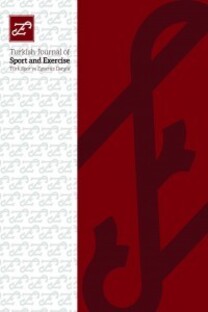A comparison between male judo-kas and karate-kaswithin body composition and physical fitness
The purpose of the study was to compare the body composition and physical fitness between male judo-kas and karate-kas. The subjects were selected from the male Judokas and Karatekas of different colleges and training centers, who had participated last 2 years at Punjab state level competitions for this study. Ten (10) male Judokas and Karatekas from three different weight categories namely light weight, middle weight and heavy weight were selected as the subject for the study. Selected body composition such as Standing Height, Weight, HumerusBiepicondylar, Wrist Diameter, Femur Biepicondylar, Ankle Diameter, Upper arm Circumference, Forearm Circumference, Thigh Circumference, Calf Circumference, Bicep Skinfold, Forearm Skinfold, Suprailiac Skinfold, Subscapular Skinfold, Thigh Skinfold, Calf Skinfold and Physical fitness variables such as 50 meter Dash, Shuttle Run, Shot Put, 600 yards Run or Walk and Bend and Reach Test were presented to compare the male Judokas and Karatekas from three different weight categories namely light weight, middle weight and heavy weight. To see the significant difference of selected body composition and physical fitness variables among the male Judokas and Karatekas from three different weight categories namely light weight, middle weight and heavy weight, the analysis of “mean, standard deviation and t test” was applied at .05 level of significance. The judokas are found to be taller and having greater diameters and circumferences and leaner in all skinfolds except suprailiac skinfold. The karatekas found to be heavier and having greater upper arm and forearm circumferences and leaner in suprailiac skinfold than judokas. However, the Judokas have greater bone mass, muscle mass and less fat percentage than Karatekas. Further Judokas have more speed, coordinative ability and endurance than Karatekas.
-
The purpose of the study was to compare the body composition and physical fitness between male judo-kas and karate-kas. The subjects were selected from the male Judokas and Karatekas of different colleges and training centers, who had participated last 2 years at Punjab state level competitions for this study. Ten (10) male Judokas and Karatekas from three different weight categories namely light weight, middle weight and heavy weight were selected as the subject for the study. Selected body composition such as Standing Height, Weight, Humerus Biepicondylar, Wrist Diameter, Femur Biepicondylar, Ankle Diameter, Upper arm Circumference, Forearm Circumference, Thigh Circumference, Calf Circumference, Bicep Skinfold, Forearm Skinfold, Suprailiac Skinfold, Subscapular Skinfold, Thigh Skinfold, Calf Skinfold and Physical fitness variables such as 50 meter Dash, Shuttle Run, Shot Put, 600 yards Run or Walk and Bend and Reach Test were presented to compare the male Judokas and Karatekas from three different weight categories namely light weight, middle weight and heavy weight. To see the significant difference of selected body composition and physical fitness variables among the male Judokas and Karatekas from three different weight categories namely light weight, middle weight and heavy weight, the analysis of “mean, standard deviation and t test” was applied at .05 level of significance. The judokas are found to be taller and having greater diameters and circumferences and leaner in all skinfolds except suprailiac skinfold. The karatekas found to be heavier and having greater upper arm and forearm circumferences and leaner in suprailiac skinfold than judokas. However, the Judokas have greater bone mass, muscle mass and less fat percentage than Karatekas. Further Judokas have more speed, coordinative ability and endurance than Karatekas
___
- AAPHER. Youth fitness test manual, Rev.ed., Washington, D.C.; American Alliance for Physical Education and Recreation, 1965.
- Brozek J, Grande F, Anderson J, Keys A. Densitometric analysis of body composition: revision of some quantitative assumptions. Ann N Y Acad Sci, 1963; 110: 113-140.
- Durnin JVGA, Wommmersly J. Body fat assessed from total body density and its estimation from skinfold thickness measurement on 481 men and women aged 16-72 years. British Journal of nutrition, 1974; 32: 77-97.
- Jensen CR, Hirst CC. Measurement in Physical Education and Athletic. New York: Macmillan publishing co. Inc, 1980.
- Johson LB, Nelson KJ. Practical measurement for evaluation in physical education. New Delhi: Surjeet Publication, 1979.
- Lokesh K. Methodology of Education Research. New Delhi: Vikas publishing house PVT LTD, 2007.
- Matiegka, J. The testing of physical efficiency. American Journal of Physical Anthropology, 1921; 223-230.
- Sandhu JS, Koley S. An Introduction to Kinanthropometry. New Delhi: Friends Publication India, 2005: 88-91.
- Singh AKJ, Roy SL. Study on Pysique Body Composition endurance and strength of elite Taekwondo players in Manipur. Journals of sports tramutology and allied sports science, 2006: 40-45.
- Wang ZM. The five level model: an approach to organizing body composition. Research A M J Human Biology, 1992: 63
- Weiner G, Lourie JA. Human Biology - A Guide field Methods (1st ed.) Oxford, England Blackwell scientific Publication, 1969.
- Wilmore JH. Body composition in sports and exercise, directions for the future. Medicine and Science in Sports Exercise, 1983: 21-31.
- Knechtle B, Knechtle P, Schulze I, Kohler G. Upper arm circumference is associated with race performance in ultra- endurance athletes. Br J Sports Med, 2008: 295.
